TUESDAY AT CES
The Fun & the Folly at CES
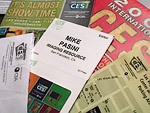 By MIKE PASINI
By MIKE PASINIEditor
The Imaging Resource Digital Photography Newsletter
SAN FRANCISCO -- The folly first. The idea that you can get anywhere at a certain time in Las Vegas during CES, for example. Notice the lack of verbs here. Exactly how we felt. Stuck in line.
|
|
We won't reveal (and can't remember) our secrets but we did manage to avoid several time-killing lines at CES, which allowed us to publish (erratically) while we were at the show. We're constantly refining our approach to our show coverage. And this time a mighty little Nikon Coolpix S510 let us capture quite a bit of the show floor as we wandered around. It got the color right in pretty dark illumination and left one hand free for grabbing free pens and Tootsie rolls.
Thanks to Adobe Lightroom, we were able to post Web galleries of those shots for each day we attended the show plus the Pepcom event (that's three total for those pollsters among you). The best way to enjoy them is to "walk along with us" by clicking on the first image and using the navigation tools (well, the right arrow key) to step on to the next so you can see each caption.
That's pretty much like walking next to us and enduring/enjoying our snide/amusing baloney/comments. But for a more reflective approach, we continue to indulge in a show report for each day (which is precisely what you are reading). There we tell a different story, one that suffers the benefit of hindsight.
And hindsight we have plenty of for this report, thanks to Friday's rather severe storm in the Bay area. Our flight home Tuesday night was delayed several hours because planes had to land by instrument at SFO (thanks to another storm) after one of the two control towers had been taken out by the Friday storm. So SFO was down to one runway during bad weather.
AT THE GATE | Back to Contents
That gave us not only time for reflection, but some great eavesdropping opportunities as well. We eavesdropped at the gate, in the belly of the plane as we lounged around before takeoff and at the baggage carousel.
The talk was all about the big TVs.
"Did you see the 150 inch TV?" more than one someone would say.
"Yeah, how do you get something like that in your house?"
"You don't. You build the house around it," the engineering grad would propose.
And, of course, the audio stuff impressed our fellow fliers too. Particularly the environments designed to deliver pristine audio. "I just sat there and chilled!" one shivering young woman said. No one offered her their coat, though.
Audio isn't something we concern ourselves with at Image Resource, but screens are another matter. They're, well, fun.
LCDs & LED BACKLIGHTING | Back to Contents
We're living through something of a revolution in display technology. It's hard to find a CRT any more. They've been replaced with flat screen LCDs on our computers, which have also replaced small TVs. And by small, we mean 37 inches and less. Above that, plasma competes with LCD technology for your eye candy dollar.
We don't personally have any eye candy dollars and find screens that large intimidating unless handled by ushers with powerful flashlights. But there was no denying the attraction of large screens at CES this year. Fortunately the buildings at the Las Vegas Convention Center are hanger size.
Our photo galleries show a few examples, but on reflection, the big news is the advent of LED backlighting for LCD monitors.
LED Backlighting. An LCD display manipulates visible ambient light to start with. But that's really not sufficient for ordinary use. So every LCD display employs some sort of backlighting.
The most common form, of course, is fluorescent lamp backlighting. That's what your laptop has, usually two (or four) long thin tubes along the top and bottom that darken at the ends with age (like the ones in the ceiling fixtures at the office). A diffuser distributes the light evenly across the screen.
But we are just starting to see LCD displays backlit with light emitting diodes. LED backlighting requires more power than fluorescent backlighting but also offer significantly more brightness, particularly if configured in an array configuration that mounts them uniformly behind the display instead of just along the edges.
The $799 ViewSonic model (http://www.zalman.com) we reported on in our Pepcom report (http://www.imaging-resource.com/EVENTS/ICES08/ces-reports/ces-pep.htm) is an interesting example of LED backlit technology, with a 12,000:1 dynamic contrast ratio and a color gamut that can display 118 percent of the NTSC guidelines (compared to 70-80 percent for most monitors).
LED backlights are not just brighter. They last longer than their fluorescent cousins. A typical LED backlit monitor can achieve 100,000 hours against the 30,000 to 50,000 hours of a fluorescent monitor, double the life. And LEDs are more stable, requiring less frequent calibration.
Bigger screens? Sure. Higher resolution than standard video? Absolutely. But the big news is better backlighting with LEDs. That gets you a wide color gamut.
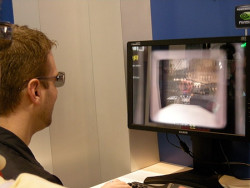
Zalman 3D. Don't look back.
3D TV. We couldn't help spending some time at the Zalman booth (http://www.zalman.com). Put on a pair of smoky 3D glasses and their 3D display technology comes to life.
They aren't smoky just to be cool, the smokiness is a reflection (cough) of their polarization with contrasts with the polarization of the two filters in front of the 3D monitors. Since the glasses and monitor are polarized at different angles, each eye perceives the display from a slightly different perspective, giving the illusion of 3D.
Frames. Color LCD technology is about as widespread as black and white LCDs were just a few years ago when every watch seemed to have one. Frames are this year's LCD watch.
As Dave pointed out, it doesn't take much to get into this game. You put together the circuit board with the generic display and you've got a digital picture frame.
So what distinguishes one company from another? Tech specs really don't (since everybody is outsourcing this stuff), although some companies do tempt with LED backlighting and timers. Several things really do, though:
- Size. There are some big frames out there (wall sized monsters mounted behind mirrors, for example) and some tiny frames (keychains with room for the family album back to 1836). Mostly, though, you're looking at sizes up to 17 inches diagonal and most smaller than that.
- Connectivity. How do you feed the frame content? By connecting it to something. A USB thumbdrive, for example. Or your laptop via USB cable. That's standard. Some frames (like those from Parrot) add Bluetooth connectivity. Great, if you have a BT device (which would be a low-res camphone but likely not a camera). Others offer WiFi, and we'll see more of this soon.
- Features. Some companies (like Pandigital) do their own firmware and can offer unique features. Westinghouse, for example, has a mosaic display mode that chops up the screen real estate into lots that are populated by different images.
- Services. But the one factor that separates your cash from your wallet is add-on services. We mentioned in our Pepcom report the intriguing Ality (http://www.alitypc.com) product of a touch-screen frame (with remote if you don't like cleaning the screen constantly) that connects to their online service to sync not only images (using Instant Messenger protocol) but Google calendars too. Kodak has recently released a firmware update to its picture frames that allows you to auto receive My Friends Album notifications from the Gallery.
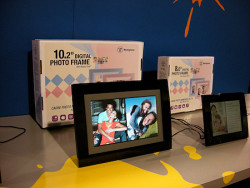
Westinghouse. Composites on the fly.
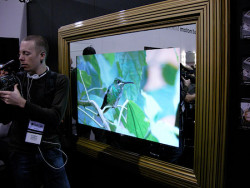
ad notam. Double sided tape mounts the LCD behind a mirror.
One thing, however, that all of these frames suffer is 16-bit color. There are no 24-bit color displays we're aware of (even on your laptop, BTW). Fortunately, there are some cool ways around this, but if you're in the market, it's wise to view one before buying one. They don't all handle this issue gracefully.
AT THE SANDS | Back to Contents
It takes a special effort to shuttle from the Las Vegas Convention Center to the Sands Exposition Center but we made that effort, as did Dave, because that's where the late registrations are boothed along with some of the smaller, more innovative ones. It's always an eye opener.
3DV. If you believe 3DV (http://www.3dvsystems.com), you are the interface. Plug a video camera into your system and your computer can watch you for a clue what to do.
The demo at the Sands booth ran a slide show using a few hand signals. The arrow keys were replaced by pointing your thumb up, down, left or right. The Enter key was the peace sign. Point the same sign to the left and it means back.
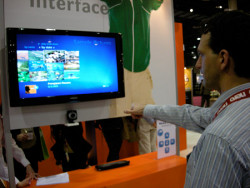
3DV. Simple hand gestures control the display.
With just those few hand gestures, the demostrator was able to navigate a picture collection just a few feet away on a large screen monitor. Most of the time <g>.
How's it work?
3DV Systems' image sensing technology generates distance data for each pixel or object seen by the video camera. Based on the Time-Of-Flight principle (how long it takes a particle to reach a detector while traveling over a known distance), the depth data is captured by emitting pulses of infrared light to the objects in a scene and sensing the reflected light from the surface of each object. Objects in the scene are then arranged in layers according to that distance data. The company has filed for 22 patents related to its technology, 7 of which were granted to date.
That may sound a little like the low-light autofocus assist on a digicam, but it isn't. AF assist just sends out a beam of light (usually orange) to help the contrast detection focusing system on the camera see something in the dark. Once the lens finds focus, it can report the distance to your flash or just record it in the Exif header.
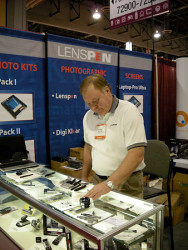
Murray at Work. The company makes superior cleaning products for most other applications.
LensPen. We had to laugh when we caught Murray Keating cleaning the display case at the LensPen booth with, ahem, a cotton rag. Murray, where's the LensPen cleaning cloth for display cases? The company, famous for its patented dry carbon compound tipped lens cleaning pens, has a cleaning solution for everything from cell phones to laptop screens. But not, apparently, display cases (yet).
We're big fans of the LensPen and never travel without one. We were delighted to see the LensBaby ship with a small one, in fact, when we reviewed that fun optic (http://www.imaging-resource.com/ACCS/LBY/LBY2.HTM). A similarly small model now sells in the MobileKlear kit for cell phones, which also includes a microfiber cloth. You use the pen on the phonecam's lens and the cloth on the case and screen.
Murray gave us a demonstration of the relative new LapTop Pro cleaning device. Just four inches long, it includes a soft dust brush to clean the screen, a slightly stiffer keyboard brush and a dry carbon pad (with a built-in replenisher) to clean grease from glass screens. You can't use the pad on anti-glare plastic LCD screens, Murray warned (just use the brush). A hand clip on the back of the small $19.95 device lets you take it anywhere.
"It's a necessity, not an accessory," the packaging says. That may sound like a bit of a stretch, but as we were packing our gear for this trip, we took a moment to clean our lenses. Our microfiber cloth only seemed to move the smudges around in interesting patterns, but the LensPen sucked them right up. Which is why we never travel without one.
Camera Armor. You don't have to be a compulsive obsessive to worry about damage to your expensive gear. You just have to have an outstanding balance on your credit card that prevents immediate replacement if anything goes wrong.
And things do go wrong. We know more than one relative or friend who can't seem to help from breaking their digicam. Dropping it usually does the trick, as does applying any kind of pressure on the LCD.
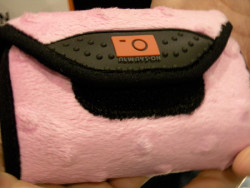
Millipod Cover. It's a wrap.
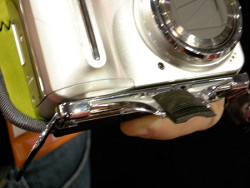
Tripod. It folds up.
The guys at Camera Armor (http://www.cameraarmor.us) are well known for their dSLR shells engineered to expose the controls, compartments and ports of the various models they support. But they've recently added an Always-On model line for digicams.
The Always-On Millipod cover is a one-size-fits-all (up to one inch thick, anyway) design that attaches to the digicam's tripod socket. A long slot in a metal bracket lets you slide the attaching screw to whatever position your camera's socket happens to be. The bracket holds one end of a soft, stretchy neoprene cover that you simply wrap over the camera and hold with its Velcro catch. When you're ready to shoot, pull the Velcro, unwrap and shoot. You can leave the $34.95 wrap on all the time. It's like having your case and freedom, too.
Plus, you can accessorize it with the $24.95 Millipod Micro Tripod folding metal tripod. That too can stay on your digicam and you probably won't even notice because it's only 5mm thick. The front leg is adjustable so you can change the angle of your shot.
Manfrotto modo tripod. Tripods must be on our minds these days because we found ourselves taken by Manfrotto's Modo. It has an unusual pistol grip with buttons to lock position, quite a different approach from the screw handles on most tripods.
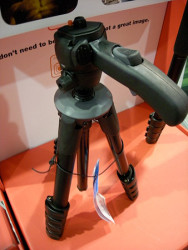
Hybrid. Set the switch to change its behavior.
Manfrotto calls it a hybrid because it's designed for either video or still photography. A dial at the base of the ball head makes the switch. In photo mode, the head can be moved quickly in any direction. In video mode, it behaves like a traditional video head with a pan handle for tilt and pan movements. To lock position, you just push the button down. To unlock, push it back up from under the handle.
There's also a compact quick release plate and an anti-twist alignment pin for video use.
Its multi-segment legs with flip locks folds down into a compact 14 or 17.1 inches, depending on the model. The oval legs guarantee they won't turn on you and add to rigidity where they connect to the tripod. There's a leg angle selector at that point which can flatten the legs (as if your tripod is doing the splits), set them to a normal 25 degree angle, medium 45 degree angle or low 80 degree angle.
The two models reach as high as 45 inches and 59.2 inches but can also squat as low as 6.1 and 6.9 inches. But they won't hold you up at just $78.95.
DAVE'S FINDS | Back to Contents
Dave had just as much fun as we did at the Sands. We salivated over his three finds as he told us about them. Here's his report:
Manfrotto modopocket. Part of the fun of shows like CES is finding the little things -- small, wonderful little gadgets that can get lost in the flurry of press releases for new cameras and other larger pieces of gear.
One such gadget is the delightful little modopocket pocket-sized camera support from Manfrotto (http://www.manfrotto.com). I can't count the number of times I've perched a camera on a wine glass and used the self-timer to get a shot of friends and family having dinner together. A wine glass works in a pinch, but it's far from an ideal camera support -- precarious and with no ability to tilt the camera up or down. When I've not been in a restaurant, I've had to press tables, walls, rocks and tree stumps into service.
Pocketable. It's surprisingly robust.
The modopocket from Manfrotto aims to solve the portable camera support dilemma and does so elegantly. Three pieces of heavy-gauge stamped sheet metal fold into a wafer-thin rectangle that attaches to your camera's tripod socket. They fold open into a mini camera-stand that can tilt up or down by 30 degrees or so and that should be able to support everything from pocket cameras to lightweight consumer dSLRs.
The real beauty of the modopocket though is that it's designed to be left on your camera all the time. Attached to your camera, it folds flat, revealing a tripod socket of its own. You can leave it on your camera, yet still mount the whole assembly on a tripod whenever you want.

In Action. And you can leave it on.
I keep wanting to use the word "slick" to describe the modopocket, but the guys from Manfrotto chided me for mentioning the name of a competitor (the company SLIK also makes camera support products). So let's just say it's really nifty and leave it at that.
The modopocket should hit store shelves sometime in the next month or so, at a retail price of $29.95.
Omega Satter/Gary Fong "Puffer". There's no nice way to say it, on-camera flash sucks. It's (sometimes) better than (literally) shooting in the dark, but the results usually leave you wishing you hadn't pushed the shutter button at all: Glaring white faces, harsh reflections and deep shadows. Ugly photos.
If you have an external flash, you can bounce its light off a wall or the ceiling to produce soft, even lighting. But external flashes are expensive and bulky, so a lot of photographers either don't own one or leave the ones they do own at home, rather than deal with the heft and hassle.
Enter photographer turned equipment entrepreneur Gary Fong (http://www.garyfonginc.com), who's made a business of developing and marketing clever solutions to strobe lighting problems. His latest creation is the "Puffer," a simple, compact, lightweight plastic contraption designed to soften the light from the popup flash heads on typical consumer dSLRs.
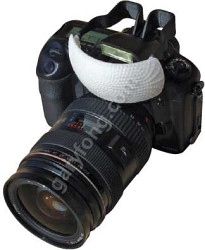
Fong. The diffuser every dSLR needs.
The device is simplicity itself, a rounded white plastic diffuser head and a support assembly that slips into your camera's flash shoe. A pair of plastic rods extend forward and plug into two sets of holes at the edges of the diffuser. The two columns of holes let you easily adjust the diffuser up or down to match the height of your popup strobe head.
We handled a sample only briefly, so will reserve full comment until we have a chance to actually use one in practice. It didn't strike us as particularly rugged, but then it probably doesn't need to be. It won't diffuse the light from the camera's strobe across a very large area, but it will provide a much broader light source than the strobe by itself. Sample photos on the product package and literature showed dramatic improvement relative to unmodified strobes. At $19.95, it seems a little pricey for a couple of pieces of plastic, but it's a whole lot cheaper than an external flash unit and the results shown in Gary's marketing materials look a lot better than those from unassisted on-camera flashes.
SPOT "Satellite Messenger". Finally, we come to a product that might seem a bit less related to photography than others we've covered, but it's one we could see being of great interest to solo nature and wildlife photographers, who often travel to the far side of nowhere in pursuit of their art.
There are dozens (hundreds?) of GPS devices that will tell you where you are, but until now, we haven't seen any that tell someone else where you are -- or whether you need help. That's the aim of the SPOT device and service (http://www.findmespot.com). Think of it as a 911 service for all the places that 911 doesn't reach. The device tracks your location using the GPS system and uses satellite communications to upload location and OK/not-OK messages back to the SPOT servers. Since it uses satellite rather than cellular technology, SPOT works anywhere on the face of the globe. (At least anywhere that the device has a clear view of the sky. Not much help for spelunkers, unfortunately.)
The SPOT device works in several modes:
- It can simply transmit GPS data periodically to display a track log for our friends and family.
- It can let you "check in" to let them know you're OK, it can request help from friends and family, giving them your exact location.
- And it can alert local emergency service providers to mount a full-scale rescue.
Check-in and routine (non-emergency) help requests are triggered by pressing the appropriate button on the SPOT device. When the signal is received by SPOT's servers, it dispatches predefined email and text messages to lists of addresses you set up in advance. (You can have separate lists for check-in and help requests.) When a 911 signal is received at SPOT's operations center, they dispatch whatever local emergency services (including search and rescue) are available in the area where you're located.
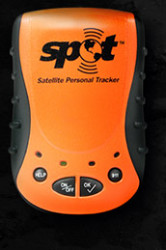
SPOT On. 911 for the wilds.
The cost for all this is surprisingly reasonable. The small SPOT transceiver sells for $170 and the standard service plan runs $99.95 per year for 911, check-in and help requests. The Track Progress function requires a $49.99 annual upgrade fee. Finally, a special insurance policy (underwritten by Lloyds of London) is available to cover up to $100,000 of additional search and rescue resources, including worldwide helicopter extraction. The insurance policy costs $7.95 per year if purchased when you initially activate your unit or $150 per year afterwards. (It seems they really want you to sign up for the insurance service up front.)
While I found SPOT personally interesting, I didn't immediately see its connection to photography. But only a little thought brought to mind landscape, nature, wildlife and extreme sports photographers, any of whom might find a service like SPOT's very reassuring.
We can't help it. We have to stop by the Brother booth before we leave the CES show floor for the last time.
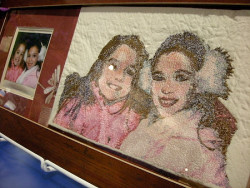
Autostitch. One of these days....
There's nothing new, June Millinger told us. But we couldn't help admiring her work on display there. She used a Innov-is 4500D sewing machine and PE-Design 7.0 software to convert digital photos into stitched portraits in various styles. Some were outlines taking about half an hour to stitch out, while others were full color renditions of the photo that took about an hour and half.
We really have half a mind to set up a system some time and surprise everybody in the family with a little automatic treasure like this. Imagine, no worries about print deterioration. Brother has a nice support site (http://www.brother-usa.com/HomeSewing) for this fun technology.
That sews up this report. We're going to get some rest before revisiting our notes for a show wrap-up.